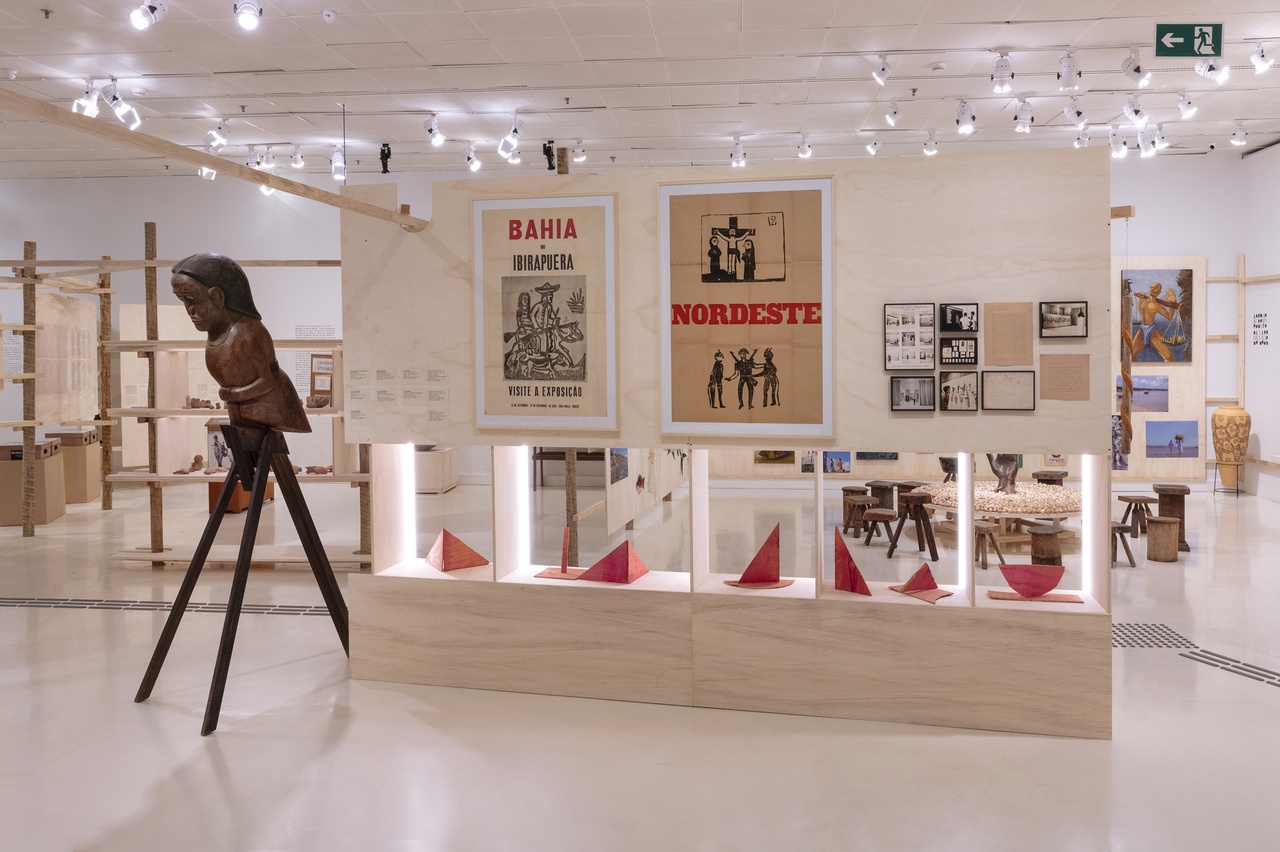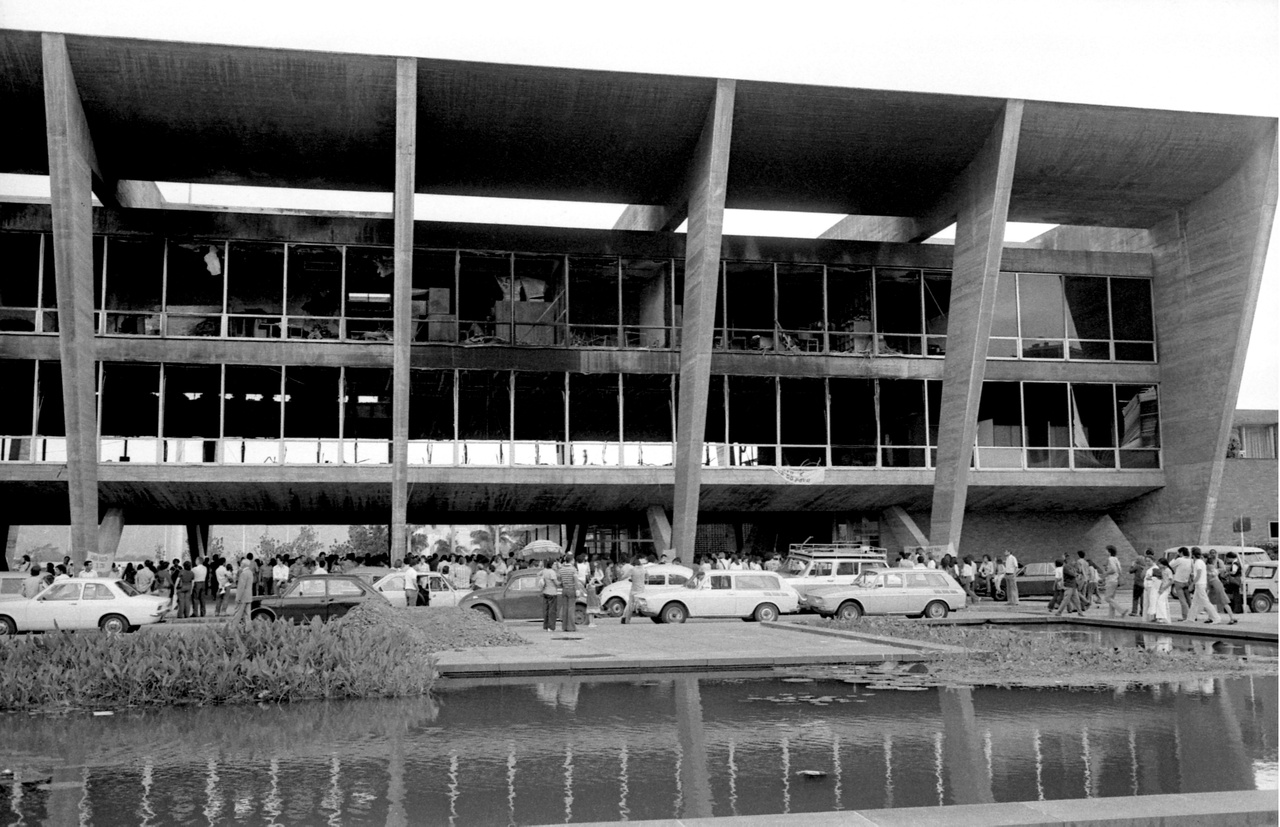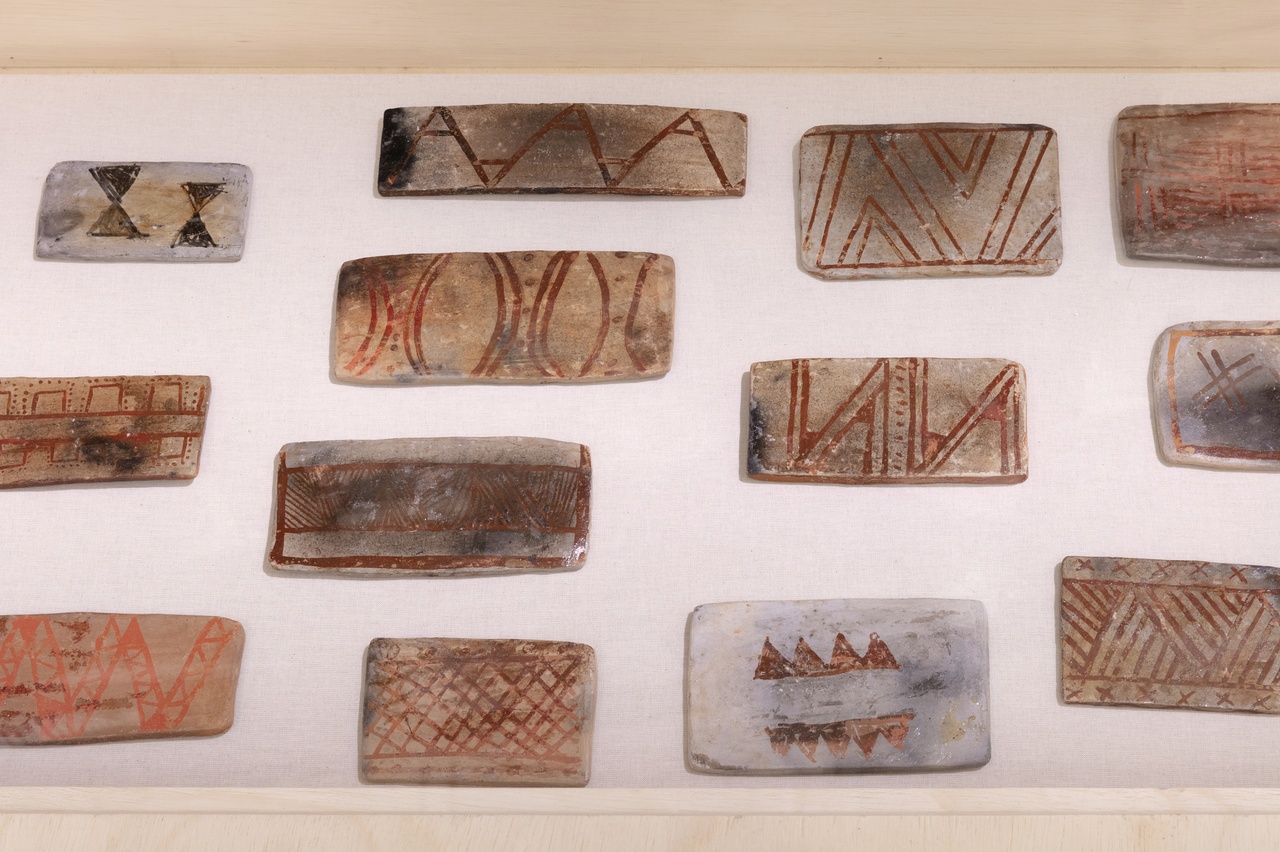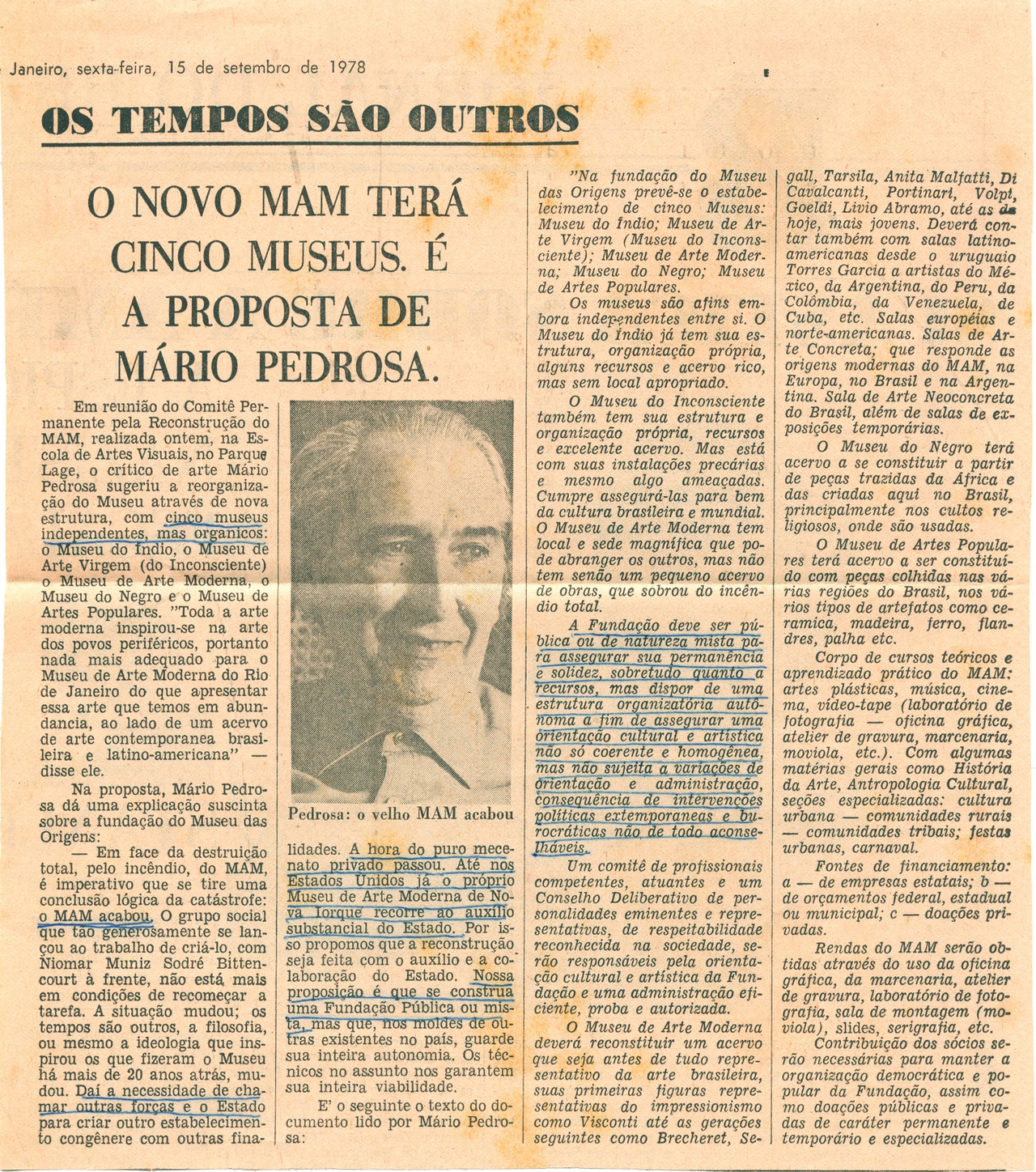“ORIGIN IS THE GOAL” Fernanda Pitta on “Ensaios para o Museu das Origens” at Instituto Tomie Ohtake and Itaú Cultural, São Paulo

“Ensaios para o Museu das Origens,” Instituto Tomie Ohtake and Itaú Cultural, São Paulo, 2023–24
Museums, historically revered as institutional custodians of cultural heritage, now find themselves navigating an era where internal and external pressures are compelling a reevaluation of their roles within contemporary society. While such discussions are permeated with aspirations of becoming dynamic spaces fostering dialogue and change, the reality within many of these establishments paints a starkly different picture. This struggle for transformation is vividly echoed in the events that unfolded in 2018. That year saw the devastating fire at the National Museum of Brazil, in Rio de Janeiro, which was the result of a lack of public funding for the institution, and it also saw the burgeoning of the Decolonize This Place movement, which echoed the overall dissatisfaction with museum politics in the United States and beyond. The confluence of these occurrences highlights the imperative for museums to transcend their conventional boundaries and recognize that inclusivity extends beyond curated narratives – it necessitates the diversification of museum staff, the incorporation of more voices with decision-making roles, and an active engagement in confronting the systemic issues inhibiting change. The ongoing discussions on coloniality and contra-coloniality inform my review of “Ensaios para o Museu das Origens (Towards the Museum of Origins),” the recent exhibition inspired by Mário Pedrosa’s visionary proposal for a Museu das Origens and held at two venues, the Instituto Itaú Cultural and Instituto Tomie Ohtake, both in São Paulo.
Fire, archives, and museums are enmeshed in Brazil’s history in unfortunate ways. The 2018 catastrophe at the National Museum evokes earlier events: when Minister Rui Barbosa ordered the destruction by fire of all documents related to slavery in the country in 1890, and when the Museu de Arte Moderna do Rio de Janeiro was engulfed in flames in 1978. Pedrosa, a prominent Brazilian art critic, responded to the 1978 fire by sketching the Museu das Origens project that same year. Synthesizing the collective discussions held in assemblies and mobilizations that took place right after the fire, the project envisioned the museum as a conceptual space, a platform to gather five existing institutions as “independent but organic” entities: the Museu de Arte Moderna, to be reconstructed with state support; the Museu do Índio; and the Museu de Imagens do Inconsciente – the latter two then thriving institutions with structural challenges – plus the Museu do Negro and the Museu de Artes Populares – both yet to be created. Central to the concept was a departure from the Eurocentric narratives that often dominated museum frameworks. It aimed to create a space that honored diverse cultural legacies, acknowledging the multiplicity of origins and narratives that form so-called Brazilian culture and how they have influenced modern and contemporary art. This approach sought to challenge entrenched notions of superiority in cultural representation, advocating instead for a more complex and diverse understanding of Brazil’s artistic expressions.

Museu de Arte Moderna, Rio de Janeiro, July 16, 1978
In “Ensaios para o Museu das Origens,” the curators Izabela Pucu, Paulo Miyada, and Ana Roman, with the collaboration of invited curators Daiara Tukano and Thiago de Paula Souza, and with the assistance of numerous other collaborators, evoked Pedrosa’s project as a mapping device. In an extensive survey, the exhibition presented around 1,000 works from 20 different Brazilian institutions. More than re-creating his 1978 proposal, the curators expanded and reshaped its impulses in moving and exciting ways. It is a somewhat unexpected achievement to make an exhibition of institutional practices without being conventional or demeaning of the audience’s experiences.
Both venues show an intricate juxtaposition of initiatives, archives, and collections, comprising written records, visual documents, artifacts, and works of art. For example, the Baniwa dictionary of graphisms, a series of delicate engraved ceramic plates produced for the Museu do Índio by a Baniwa group of women from the Amazon, shares space in the exhibition with the remarkable objects of the Maracatu Elefante, an Afro-diasporic performance culture from Northeast Brazil, preserved in the Museu do Homem do Nordeste, as well as with the record collection of mostly Yiddish, Hebrew, and Portuguese lullaby songs from the Casa do Povo library. Each institution’s presentation in the exhibition served as a poignant narrative, engaging the public in a thought-provoking exploration of particular aspects of the respective archives and collections that highlight multifaceted struggles inherent in safeguarding and presenting memories, but above all, in making them relevant to now. The sheer existence of those institutions facing constant menace – from funding cuts to threats from conservative politicians – confronts the complexities surrounding collective historical narratives, interrogating established truths while providing perspectives that challenge received ideas and enrich our understanding. The selection of institutions moved beyond the cultural boundaries of Southwest Brazil and away from traditional museum formats. Importantly, the exhibition also highlighted small institutions alongside larger ones.
The above-mentioned example of the Baniwa dictionary of graphisms underscores the impact of such institutions and their work. Faced with the realization that aspects of their ceramic practice had been lost due to the violent ecological and cultural impact of colonialism in the 20th century in the region, the Baniwa women went on a visit to the Museu do Índio to see old pieces made by their people, and in a workshop hosted at the museum, the participants exchanged oral knowledge and retrieved creative methods, or “cosmotechnics,” [1] of their ancestors. The result was the production of 100 new pieces for the collection and the compilation of this iconographic dictionary of their ceramics as a form of continuous transmission of remembered knowledge.

Baniwa graphisms
As stated by the curators, the presentation of aspects of these institutions’ archives and collections forms a web of “memory gestures.” By appreciating their juxtaposition in the exhibition space, we better perceive the work of those institutions as critical experiences of memory building and preservation of material and immaterial heritage around the country. A dialogical aspect is reflected in the display concept of the two venues, which abdicates chronological or geographical order. By visiting both sites, one can wander through diverse and unique perceptions of memories of multiple ancestries from different communities and contexts that intertwine yet maintain their specificity. In one of the exhibition venues, coming together in a fertile encounter about diaspora and resistance, are a group of functional replicas of African musical instruments; the collection of Yiddish and Hebrew records from the Jewish cultural institution Casa do Povo; and contemporary recordings of vissungo songs (enslaved miners’ work songs from the state of Minas Gerais) created in the context of the Musikfabrik project by musician, researcher, and ethnomusicologist Spirito Santo. Indeed, what the exhibition cast in relief is how Pedrosa’s proposal resonates within the practices of several existing museums and archives in Brazil, presenting examples of what Françoise Vergès has been calling the “post-museum”: institutions that nurture spaces of belonging, that embrace and foster a multiplicity of memories and cultural narratives, resisting the tendency of presenting themselves as foundational myths or universal syntheses, or treasure repositories of the Western world.
The general principles of Pedrosa’s project, the emphasis on the creativity of psychiatric clients, of Indigenous, Afro-diasporic, and self-taught artists and groups, are maintained in the current exhibition. Yet, one major change is worth noting: if the tone of Pedrosa’s discourse was about acknowledging the influence of “peripheric” or “marginalized” creativities on modern and contemporary art and culture, the current question is not about influence, but empowerment. A great number of the institutions presented in the exhibition are organized and run by their constituents and communities. Self-presentation and self-articulation are key, and they represent a pivotal departure from the Western “universalist” approach that still marked Pedrosa’s language and thought.
Instead of presenting “the memory of Brazil’s diverse constituent matrices,” a somewhat unfortunate curatorial statement in the exhibition’s opening text, the curatorial approach successfully articulates dissident practices of memory and heritage that escape totalizing perspectives marked by the notion of origin which had still been significant to Pedrosa. Memories are not subsumed in singular concepts that uphold unified conceptions of a nation. It is the community that makes those institutions stronger and gives them meaning. Community makes them relevant and topical, enmeshing past, present, and future.
Here, the concept of ancestry, as expressed by various “contra-colonial” communities, to use the late Antônio Bispo dos Santos’s, aka Nego Bispo’s, terminology, holds significant importance. This notion isn’t entirely absorbed by modern Western concepts of history, which are heavily influenced by progressive ideologies and linear views of time.

“Jornal do Brasil,” September 15, 1978
Contra-colonial notion of ancestry challenges Western dichotomies of past and present. It rejects the idea that the contemporary must align with the latest technology or the newest developments, as asserted by the universal truth of modern Western progress ideology, a belief that demands dismantling – done not, as Audre Lorde can remind us, with the master’s tools. If ancestries – practices, sensibilities, cosmologies – hold relevance to today’s existence, they are contemporary. That’s why contra-colonial thought rejects the notion that “origin” is in the past, static, and resistant to change. Indeed, if an idea of origin is to be invoked, it may align more closely with what Walter Benjamin interpreted from Karl Kraus’s renowned quote: “origin is the goal.” [2] In this connotation, origin and tradition are not inherently pure, untouched, and relegated to the past. As a goal, origin can point to something other than itself; it can aim for an open future, projected “in the open air of history.” [3] The origin can catalyze transformation – fulfilling past aspirations, promoting restorative justice, and ending the violence perpetuated by colonization and the tyranny of progress.
This is why the juxtaposition of archives and collections with commissioned contemporary works, while commendable, might appear as an unnecessary gesture, giving excessive credit to museum strategies already explored in “updating” their collection displays through contemporary art inclusion. Everything else presented in this exhibition is contemporary already. Every object, song, and creative expression presented belongs to today. What they hold, what they represent, does not need contemporary art’s endorsement. Had all the works directly engaged with the collections or archives and facilitated encounters, similar to the ongoing project by Yael Bartana with the Yiddish Coral Tradição and the Afro-diasporic Ile Oba di min block, the impression might have been different.
As an exhibition, “Ensaios para o Museu das Origens” amplified a chorus of voices and acknowledged the multiple efforts to stop the ongoing global disaster. It offered evidence of the various ways institutions, both large and small, engage in memory work that can change the present and the future. Furthermore, as a realization, it extends an invitation for the network of institutions connected by the exhibition space to persist and promote exchanges, peer learning, and mutual support.
“Ensaios para o Museu das Origens,” Instituto Tomie Ohtake and Itaú Cultural, São Paulo, September 9, 2023–January 28, 2024.
Fernanda Pitta is an art historian and assistant professor at the Museum of Contemporary Art of the University of São Paulo, Brazil. She currently coordinates the Brazilian team of the research project Decay without Mourning: Future Thinking Heritage Practices (Riksbankens Jubileumsfond).
Image credit: 1. © Everton Ballardin 2. Archive of Celso Guimarães; 3. © Everton Ballardin; 4. Archive of MAM Rio; all images courtesy of Instituto Tomie Ohtake
Notes
| [1] | I refer to the concept of cosmotechnics, as developed by Yuk Hui, since it properly describes the connection between cosmology and technology for Indigenous peoples. See Yuk Hui, Art and Cosmotechnics: For A Renewed Concept of Technology in the Anthropocene (Minneapolis: University of Minnesota Press, 2021). |
| [2] | Walter Benjamin, Selected Writings, vol. 4, 1938–1940 , ed. Howard Eiland and Michael W. Jennings (Cambridge MA: Harvard University Press, 2003), 395. |
| [3] | Ibid. |
